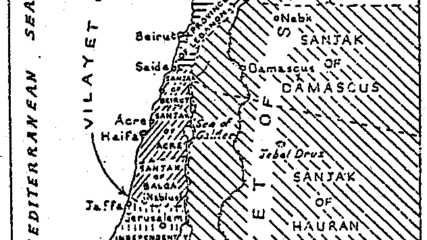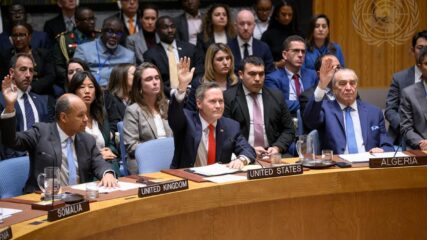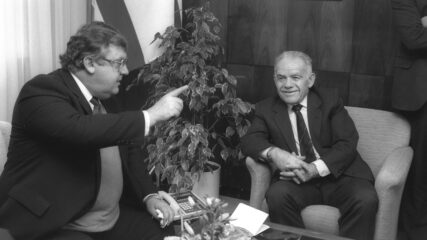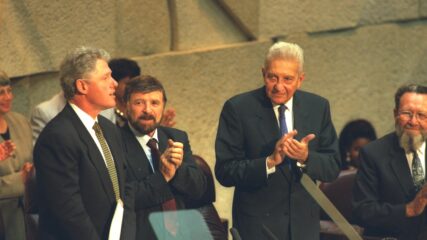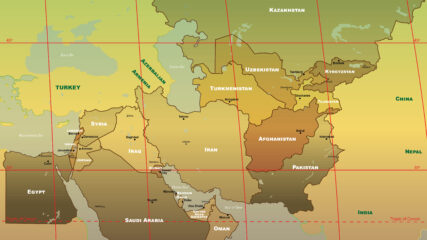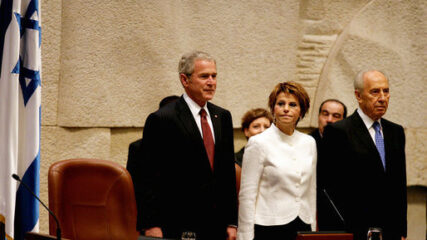November 29, 2023
Ken Stein (appeared in The Jerusalem Strategic Tribune, November 2023), Part I and Part II
Since the June 1967 war, anti-Israeli sentiment on U.S. campuses has grown to extraordinary proportions, merging with previously evolved anti-Zionism that emerged in late Ottoman and Mandate times. Hamas’ October 7 murderous killing of 1,300 lives and 239 hostages was a disastrous tsunami of indiscriminate violence. It hit Israelis with enormous ferocity and sudden force in the villages and kibbutzim on the Gaza border. In contrast, the ensuing explosion of anti-Israel protests on American campuses and streets was a continuation of simmering anti-Israeli outbursts.
What was unexpected, however, was the intensity and anger of these public protests. At the core of both was lethal and indiscriminate antisemitism. This antisemitism includes extreme verbal degradation, indiscriminate killing of Jews, their demonization, delegitimization of Jewish self-determination, and systematic sowing of doubt that Zionism and Israel are just and moral, and therefore not worthy of sustained emotional, physical, and financial support, otherwise defined as “distancing.”
This essay identifies multiple reasons for the growth of anti-Israeli sentiment on American campuses. It asserts that 1) both the Hamas massacres and the anti-Israel demonstrations reflect delegitimizing of Jews as a people, undercutting the legitimacy of Jews to constitute a state. Embedded in modern Arab and Muslim attitudes toward Zionism and Israel are a century of denigration, boycott, and belittlement interrupted with significant, yet transactional Arab acceptances of the Jewish state; 2) the public and scholarly realms have become increasingly abusive of Israel, acerbic toward her policies, and vengeful toward her political leaders; 3) campus teaching of the Middle East and Israel in the US since 1967 has disfavored students broad learning about Israel except for studying Hebrew; 4) college professors and campus organizations have increasingly preached anti-Israeli views to unsophisticated, apathetic, and unknowing students; 5) pre-collegiate learning about Zionism and Israel, for Jewish and non-Jewish students alike, is sporadic, often lacking in content and concept, and self-limited to less than half of American Jewish students between the ages of 5 and 18.
Historic Anti-Zionism as a Core Element of Modern Antisemitism
Conceptually, the brutal killings and anti-Israeli protests are linked by a prolonged and relentless objective to degrade and obliterate the inalienable right of Jews to self-determination in their own state. Anti-Semitism has ancient roots in thousands of years of Jewish history. The Salience of Islamic Antisemitism, in the words of Martin Kramer, may be found in numerous Koranic passages, and earlier in Christian theology, reaffirmed as anti-Zionism in Ottoman and Mandatory Palestine through local Arab leadership’s rejection of Jewish state-building. It was summarily expressed by the Arab League Secretary General, Azzam Pasha in September 1947, “The Arab world is not in a compromising mood. We shall try to defeat you. I’m not sure we’ll succeed, but we’ll try. We were able to drive out the Crusaders, but on the other hand we lost Spain and Persia. It may be that we shall lose Palestine. But it’s too late to talk of peaceful solutions.”

Delegitimizing Israel was carried forward by the USSR and Soviet Bloc states in the Cold War to curry favor with states recently independent of Western colonial presence. It took the forms of an Arab economic boycott of Israel and denial to Israeli diplomatic representatives of access to acceptability as a legitimate state. In the Arab world this led by Nassar’s May 1967 rhetoric to eliminate Israel. It was sustained after the June 1967 war with a general Arab policy of ‘no negotiation, no recognition, no peace’ with Israel stated unequivocally at the 1967 Khartoum Arab League Summit Resolutions. Hamas reaffirmed that 1967 concept in the 1988 Hamas Charter. Article 15 of the 1964 PLO Charter asserts that “the liberation of Palestine…aims at the elimination of Zionism in Palestine.”
The disparagement chain against Israel is continuous, intervening with times of Arab state diplomatic recognition. Yasser Arafat, Hafez al-Assad, the Popular Front for the Liberation of Palestine, Palestine Islamic Jihad, and many Palestinian leaders held steadfast to the same central objective of seeking Israel’s disappearance or eradication. Faisal Husseini, a prominent PLO leader in Jerusalem, said on September 9, 1996, on Syrian Television, “All Palestinians agree that the “just boundaries” of Palestine are the Jordan River and the Mediterranean Sea… realistically, whatever can be obtained now should be accepted and that subsequent events, perhaps in the next fifteen or twenty years would present an opportunity to realize the just boundaries of Palestine.”
According to Shakyh Ahmed Yasin, in March 2002 in al-Majallah, a founder of Hamas, “We declare very clearly that Palestine from al-Naqurah to Rafah and from [the River] Jordan to the Mediterranean Sea is the land of Palestine. There is no harm in establishing a Palestinian state on any part that is liberated at this stage, but without this meaning conceding the remaining territories of Palestine. This is the difference between the brothers in the PA and us.” Hamas leader Yahya Sinwar was quoted on al-Jazeera on May 26, 2021, “We support the eradication of Israel through armed Jihad and struggle. This is our doctrine.”
Advent of Anti-Israel Sentiment on the American Campus
Anti-Israeli sentiment on American college campuses and in the public sphere is of recent vintage, while Middle Eastern anti-Zionism has evolved over the last century. American campus anti-Israeli sentiment emerged notably after the June 1967 War. It grew slowly on campuses as Israel was flipped from a sympathetic embrace as ‘David’ to being criticized and vilified as “Goliath,” primarily because of its territorial successes. Only in the mid-1970s did the US government and the national media begin to take note of Israeli settlement building in the West Bank and Gaza.
Growing anti-Israeli sentiment evolved from a variety of sources. It was popularized by writers, scholars, professors, politicians, and the media. Articles began appearing first in the Arabic media viewing Israel as an “oppressor tyrannizing an oppressed people,” simultaneous to Palestinian engagement in terrorism, with the 1972 Munich Olympic massacres standing out along with airplane hijackings, and attacks on Jewish institutions world-wide. Palestinian terrorism against Jews and Israelis was condoned or only mildly criticized. Israel had in the 1967 and 1973 Wars defended itself. Then Israel engaged in a preemptive war of choice with the 1982 invasion of Lebanon, with the Sabra and Shatila massacres of Palestinians by Israel’s Phalange allies. Responsibility was laid at Israel’s feet, and Israelis themselves condemned the war, reinforced by the Israeli Commission of Inquiry in the Kahan Report
The Carter administration had just left office, having become the most openly critical US administration of Israeli political behavior to that date in the 20th century. Carter’s policies were inspired and led by his National Security Adviser Zbigniew Brzezinski who cajoled and offered to pressure Israel in public if it did not withdraw from the West Bank. In addition, Brzezinski sought to severely reduce the influence of the American Jewish community upon Middle Eastern foreign policy making.
I saw firsthand while working at the Carter Center at Emory University how Carter, upon entering his post presidency, placed responsibility and blame on American Jews for his loss to Ronald Reagan in the presidential elections of 1980. He said, ‘they and the evangelicals abandoned me in 1980.’ He repeatedly stigmatized Begin in the public sphere and in the Emory classroom. Moreover, for four subsequent decades after he left office, he carried anger towards Israel for two reasons: denying his administration a comprehensive peace between Israel and all Arab states, which was never realistically possible; and continuing settlement building and expansion in the Occupied Territories. Later in the 2000s, Carter cultivated a decade of embrace of Hamas, while he promoted the view that Israel was an ‘apartheid state.” Whatever one’s view of Israel’s practices in the Territories, or the use of the term apartheid, he popularized it as an accepted descriptive of Israel’s political behavior over decades in the West Bank, Gaza Strip and Jerusalem. With the use of ‘apartheid’ he implied that Israel was racist. He legitimized the use of the term to describe Israel because others heard and saw a former president embrace it wholeheartedly, his disclaimers notwithstanding.
From Carter forward, American presidents with varying degrees of intensity criticized Israel’s building of settlements, its management of Palestinian affairs, and failure to do enough to move a Palestinian-Israeli negotiating process forward. Carter and subsequent presidents always prefaced their criticism of Israel with iron clad support for Israel’s security. Israel continued to build and expand settlements which poked fingers in the eye of many who supported Israel but also wanted an equitable (whatever that meant) political outcome for the Palestinians. The first Palestinian intifada (1987-1992) generated dismay among those on the political left because Israel used more force in quelling Palestinians violence in the territories; Israel’s behavior was routinely categorized as not ‘proportional’ however that was defined. More frustration developed from the unrealistic expectations that the 1993 Oslo Accords between Rabin and Arafat would also result in a peace treaty as had unfolded between Begin and Sadat.
Many on American campuses and across the world erroneously believed that Palestinian statehood was promised in the Oslo Accords. Still the attitude was held that only if Israel would do more, negotiations would ensue; but Arafat was not interested in ending the conflict with Israel, and Rabin’s assassination in 1995, again exploded massive unrealistic expectations that negotiations might have continued under his leadership as prime minister. No evidence ever appeared that Rabin was prepared to promote an independent Palestinian state, though be believed that Israel should get out of the lives of the Palestinians. Just before Oslo was signed and Arafat recognized Israel, Hamas embraced all the views of Palestinians, in the Middle East and elsewhere who totally rejected Arafat’s recognition and legitimization of Israel. In early 1996, Hamas timed a series of bus bombings that killed hundreds of Israelis to effectively help push Benjamin Netanyahu past Shimon Peres as Israel’s next prime minister.
Anger with Israel spilled out into courses taught on campuses. Israel was using check points, collective punishment, building settlements, erecting the security fence, known in the vernacular as the “Apartheid Wall,’ and repeatedly its politics and policies were defined as ‘racist,’ ‘colonialist,’ engaged in ‘ethnic cleansing.’
After Rabin’s assassination, the clarion call for a two-state solution steadily dominated political hopes. In the first decade of 2000, Israeli Prime Ministers Ehud Barak, Ehud Olmert, and Bibi Netanyahu spoke in support of two states for two peoples, all with some limitations on governing prerogatives, with no Palestinian leader stepping forth to challenge Israeli overtures.
The campus gradually became a hotbed of Israeli disfavor. Then anti-Israel voices abounded on many fronts. In 2003, the Boycott Divest Sanction (BDS) movement was formed, whose goal of ‘ending the occupation’ did not define itself as limited to removing Israel from the territories secured in the June 1967, but rather included all of Israel from the Jordan River to the Mediterranean Sea.
In 2006, President Carter published Palestine Peace not Apartheid where he suggested that Palestinians stop their attacks on Israel only after Israel accept a roadmap to negotiations. Beyond the book, Carter went around the country to promote his view that Israel was brutalizing Palestinians. He ripped Israel, its policies and leaders at every opportunity, his book became a regular text in Palestinian-Israeli conflict courses.
In 2007, two professors Walt and Mearsheimer published The Israel Lobby which claimed that American support for Israel was not in the US national interest and was morally unjustified. In John Mearsheimer’s speech on April 29, 2010 at the Palestine Center in Washington, DC, he ridiculed major Jewish leaders as ‘new Afrikaners,’ putting a nasty verbal mantle on David Harris, Abe Foxman, Lester Crown, Mort Zuckerman, Malcolm Hoenlein and a host of others, an example of demonizing and degrading American Jewish leadership.
In November 2007, J Street was formed and gradually secured support from many American progressives who opposed Israel’s policy in the Territories and toward the Palestinians. In 2008, Tel Aviv University Professor Shlomo Sand published The Invention of the Jewish People, claiming that Zionist attachment to the land of Israel is a myth. After Netanyahu imposed himself in 2015 at the US Congress with his angry speech against American support of an Iran deal, a new low point in US-Israel relations was reached in the public and on campus.
In the 2016 and 2020 presidential election campaigns, Democratic candidates for office advocated halting or slowing American military support for Israel until a Palestinian-Israeli negotiating process unfolded. In the center and on the left of American politics, the abundant dislike for Trump was transferred to Prime Minister Netanyahu who was seen as equally despised.
Campuses had become breeding grounds for anti-Israeli sentiment, catalyzed by two student groups with chapters across the country, Students for Justice in Palestine established in 1993, and Jewish Voices for Peace established in 1996. On various campuses and with varying degrees of followers, both persistently tarred Israel as racist, implying that any Jewish student who supported Israel was automatically complicit in Israel’s policies. Across the US in many campuses, student government organizations increasing passed anti-Israeli resolutions; simultaneously, Jewish college students voiced discomfort that their safety was threatened.
As Israel and her supporters were held responsible for Israeli actions vis-a-vis the Palestinians, no matter how much Palestinian Arab violence was perpetrated against Israelis in attacks in restaurants, at religious functions, on public transport, or in public places, the abusive language and misinformation continued. In the college classroom, mostly tenured faculty criticized and condemned Israeli policies. Anger against Israel evolved into proclaimed boycotts of Israeli universities, Israeli professors, and academic links to Israel.
After the October 7 murders, the Middle East Studies Association, the major organization of Middle Eastern college professors in North America issued its statement on October 16 that read, “MESA’s Board of Directors has previously addressed the broader context emphasizing how the decades-long Israeli military and government attacks on Palestinian students, teachers, and educational facilities are part of a broader political, administrative, and legal system of racial discrimination and domination – regularly enforced through violence – that has defined the Israel government’s treatment of the Palestinian people.”
The October 7 attack and the anti-Israel demonstrations on campus are two sides of the same coin. Jews in Israel and in the Diaspora are the focus of delegitimization by groups deeply antagonistic to any form of Jewish nationalism or nationhood.
Middle Eastern Studies
For half a century, one-sided Arab views of Middle Eastern Studies in the United States, articulated clearly by Martin Kramer, and underdeveloped Israel studies shaped student understandings of the Arab-Israel conflict. From the period after the October 1973 War and the quadrupling of oil prices, businesses and universities across the world chased after petrodollars.
By the middle of the 1970s, according to a 2022 article in Tablet Magazine, foreign funds from oil-producing countries had hijacked the direction of Middle Eastern Studies in American colleges. Explicitly or not, foreign government funds shaped the nature of research and helped determine the granting of fellowships and the hiring of faculty. And if a researcher or candidate for a position had a social media footprint, it was revealed as an important variable to be considered in hiring college faculty. A social media footprint was often times considered as important or more important than the quality or quantity of reputable publications one had written in scholarly journals.
I can speak to my own experience as a candidate for an entry-level tenure track position in modern Middle Eastern history at Harvard in 1975-1976. After my job talk, where I summarized my dissertation findings, a well-known professor of Islamic art history confided in me that “although I was the top candidate in the applicant pool, Harvard could not hire me.” He continued, without me asking for the reason, to explain. “We have just received a large gift from a Middle Eastern Arab oil producing country.” He did not say more. I did not need to ask. So, I ended up in Atlanta for a three-month temporary position in 1977 that grew into an extraordinarily productive 44 years.
Over the last half century, university job descriptions have been carefully worded to narrow the possibility of faculty with a pro-Israeli bent even being considered for new faculty slots. Stories abound about departmental search committees deciding not to invite candidates to campus for final interviews because they may have studied in Israel or have done research in modern Jewish history, though the advertised position in the department might be in teaching modern India or American Civil War history, or some other specialty.
In the 1960s and early 1970s, only a handful of Jewish Studies programs like that at Brandeis included Zionist or Israel learning as a priority in their offerings. From the 1970s onward, modern Jewish history on American campuses and in pre-collegiate Jewish schools was overwhelmed by the study of the Holocaust. Only in the year 2000 and later, did Centers for Israel Studies emerge in the US (ours at Emory was the first in the US along with that at American University in 1998).
Many Jews worldwide simply are not aware of early Zionist history and therefore commence their historical story about Israel based on the sharply protruding moment in modern Jewish history from 1939-1945, as if Zionism and Israel popped onto the international scene like a ’Big Boom,’ rather than through copious ‘Intelligent Design.’ Ilan Troen notes in his excellent article Israel as Field of Study that only from 1985 forwards did Israel Studies emerge as an area of academic scholarship.
The absence of learning the Zionist and Israel story at colleges meant that those who went into teaching middle schools and high schools did not have the wherewithal from a field of study, or even from one course, to teach about Zionism or modern Israel. It is a canard that faculty in Jewish and public schools intentionally failed to teach what happened to the Palestinians in the late 1940s. Teachers and often rabbis could not teach what they were not taught. Who among these teachers, for instance, were taught that there was a geographic, demographic, and economic nucleus for a Zionist state in 1939? Who among these teachers were taught that the Mufti of Jerusalem rejected a majority Arab state in 1939 because he did not want any Jewish presence west of the Jordan River? When I presented several pages of socio-economic evidence from original sources on Zionism’s successes in the 1930s to a large group of rabbis assembled in Atlanta a decade ago, the common remark was, ‘we did not learn this in rabbinic school or in Israel when we studied there!”
As the Arab Israeli conflict became more controversial, relevant academic departments might ask a colleague to teach a course on the conflict. This was usually a faculty member in international relations or comparative government where some training existed on Middle Eastern history and politics with an intellectual preference or bias from an Arab view of the conflict. With a dearth of domestically trained scholars on Israel, visiting Israeli professors were recruited to teach at American universities. Many had left of center leanings and presented Israel as opposed to a negotiating process and hostile to the Palestinians, regardless of Israeli attempts made to rejuvenate negotiations. Teaching aspects of Israel studies often became teaching anti-Israel politics and policies.
In the first two decades of this century, many of us who joined the college teaching ranks in the 1970s were retiring and often departments or deans decided that the hiring of specialists in other fields was more important than keeping on a faculty member with Israel as a specialty. Last year, 2022-2023, to my knowledge there was not a single permanent academic position posted for candidates to apply for a tenure track position in fields of Israel studies in the United States. There were plenty of temporary positions. How was it that the Jewish Theological Seminary in New York for more than a decade did not hire a permanent faculty member to teach would-be rabbis about modern Israel? When I asked a high-ranking executive, he told me, “the funds were not in the budget.”
Hence anyone who taught Israel or the Arab Israeli conflict likely had been exposed to broader Middle Eastern studies generally and not to Israel studies specifically. Their teaching was naturally informed by American politics and events in the Middle East during their graduate education, or they felt that their personal views had to be presented as the dominant takeaways in the classroom.
Polemical Preaching in Teaching Israel
Whereas graduate schools fifty years ago were dedicated to teaching historical scholarship, which required the blending of different points of view into a nuanced history, today’s college courses are often based or heavily interlaced with political viewpoints as expressed by the teacher. In the late 1960s, we were taught not to provide our political or personal viewpoints to students, no matter how strongly we felt about a topic. Today, instead of broad histories and over-arching concepts taught, the narrow narrative of one view over the other is presented, boiled down to teaching the conflict as ‘Why Us, Not Them.”
Narratives of the conflict are often taught by promoting distinctly Palestinian viewpoints that seek to include a lock on victimization, highly pejorative language about Zionism and Israel, so a student learns or is exposed to delegitimizing Israel. When the parochial narrative is taught, content, context, perspective, and critical thinking are mostly omitted.
Highly significant is where the professor chooses to begin in teaching the conflict. If one starts with the aftermath of the June 1967 war, one omits the reasons for the war; if one starts in 1945, then the Holocaust is emphasized as the reason for Israel’s creation and the question is inevitably posed why the Arabs of Palestine should be penalized for what the Europeans did to Jews? If one starts in 1917, one focuses the story on British colonial presence and denying the Arabs of Palestine self-determination but fails to mention that the Arab elite in Palestine were opposed to even limited Arab self-determination lest their self-anointed leadership positions be questioned. Telling the story of Palestine from this view makes the case for the injustice done to the Palestinians but fails to state that the Arab leadership could have embraced any number of British high officials who wanted to aid them against Zionism, but they repeatedly declined. Boycott became the consistent policy of choice for Palestinian Arab leaders during the 25-year period of the British Mandate.
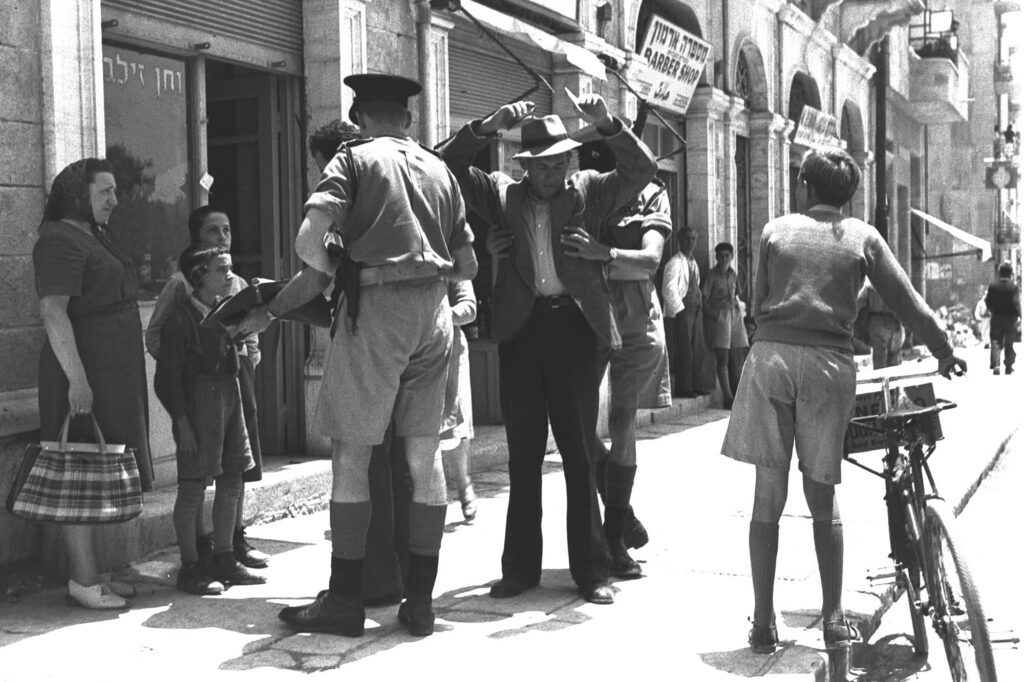
For years, a professor I knew offered students extra credit toward their final grade if they watched a film series where each selection blistered Israeli politics, politicians, and actions. In another course, titled “Palestinian and Israeli literature: a look at two national identities,” a professor imposes a blatant anti-Zionist viewpoint. The professor frequently shouts at students in class and in one case continued berating a student after class for simply taking a different viewpoint and daring to challenge the professor. Polemically oriented anti-Israel professors intimidate students, in effect challenging them to go over their heads and complain to department heads and deans, relying on the umbrella of academic freedom to protect proselytizing viewpoints. Parents of college and pre-collegiate middle school students have over my lifetime sought advice on how their kids should handle such encounters.
In a very cursory review, since Hamas’s massacres on October 7, pedagogical malpractice has flourished. Most anti-Israel teachers are more subtle than the Cornell professor who described the October 7 pogrom as “exhilarating” or the UC Berkeley instructor and the UCLA and University of Virginia professors who once again offered students extra credit for attending anti-Israel events.
It is useful to review the content of a syllabus, where the professor puts on paper or online the material to be taught. Often if the syllabus is egregiously anti-Israel and only online, and the professor does not want to leave a political footprint, the syllabus will be taken down from the department website. Note for example the Fall 2023 course at the University of Maryland, ‘History 319K Israel’s Occupation’ cross-listed as an Israel Studies course and taught by an associate professor of history in the Center for Jewish Studies. The brief course description includes the words “Apartheid” “colonization” “Palestinian resistance.”
The bias of professors is encoded in word choice. For example, terrorism is euphemized as “resistance” and massacres as “uprisings.” The “occupation” or “occupied Palestine” often refers not just to the West Bank but to all of Israel; the closure of Israel’s borders with Gaza after the Hamas takeover in 2007 is a “siege” and the barrier Israel erected during the Second Intifada to intercept would-be suicide bombers is the “Apartheid Wall.” The displacement of Palestinians in 1948 in a war they and Arab states started and from which many fled is bundled in the terms “ethnic cleansing” or “mass expulsion.”
No matter your personal view on whether or how the Israeli-Palestinian conflict may be resolved, it is indisputable that college campus teaching of Israel is flagrantly biased, insufficient in quantity and quality, and perhaps not amenable to a quick or long-term fix. There are bright lights. The Winston & Strawn law firm in October 2023 rescinded an NYU Law School student’s offer of employment after the student had apparently written, “Israel bears full responsibility for this tremendous loss of life.” On October 11, 2023, Emory University President Greg Fenves, in a letter to faculty, encouraged respectful disagreement in campus discussions, noting that “the reality of Jews being senselessly murdered and taken as hostages must be condemned in the strongest possible terms.” In the days after the attack, I was stunned to hear demonstrators cavorting across major American campuses chanting ‘From the River to the Sea. No one can prolong the myth that ‘end the occupation’ only means leaving the territories acquired in the June 1967 War.

Conclusions
What are pre-collegiate Jewish students taught about Israel before arriving on campus? Do they possess an understanding of why Israel is central to their Jewish identity? Do they understand the meaning of “from the River to the Sea,” or the geographic definition applied to calls to ‘end the occupation,’ or can they tell you their understanding of what it means or why it is relevant for Jews “to be a free people in our land” (in the words of Israel’s national anthem)?
In 1998 two Atlanta Jewish day schoolteachers asked for help in crafting a course on Zionism and modern Israel for their school. First through Emory I and a small staff assisted them and other Jewish teachers across the country in generating teaching materials based on sources and documents for teaching Zionism and Israel.
After Carter published his egregious book Palestine: Peace Not Apartheid in 2008, I established the Center for Israel Education in Atlanta to broaden the reach from rabbis and teachers to Jewish youth, adults, and others. Carter intentionally and repeatedly eroded the successes of Jewish self-determination. My problems with his book were many. I could not hold a former president accountable, but I could help Jewish educators help their students who wanted to learn Israel’s story unvarnished, with accuracy and through sources. As we offered more programs with content and gave them access to scholarly materials that often otherwise sat behind high priced journal paywalls, or were only published in Hebrew, their embrace was gratifying. In a survey the Center conducted from January to March 2023, 37 rabbis from all denominations found that 90% of them want to be able to teach more about Israel and wanted the kind of materials the Center offers.

Student missions to Israel and gap years between high school and college can stem an anti-Israeli emotional tide. But embracing content will matter after they return and go off to college. On November 12, our Center convened 41 Jewish students from 18 schools, (only 12 from Jewish schools) across Atlanta to address the Hamas-Israel War. Any assumption that these Jewish students, like most high school students, are not interested in history was debunked. The teens consumed content, with many wanting to come back again in the spring. Their reflections included: “these Israel learning sessions made me proud to be Jewish”; “this experience helped me reflect on what’s happening in Israel and my role in it.”
Delegitimization of Israel is antisemitism. It is sustained by physical violence and abuse of the education system in the United States. Anti-Israeli learning has percolated down into public school teaching in various locations in the United States. The October 7 genocidal attacks against Israelis and torrent of verbal and physical attacks on American campuses and elsewhere must be confronted.
World Jewry today is without a doubt collectively the most powerful Jewish generation that ever existed, so we have the capacity to respond. Do we have the will to do so with relentless and unembarrassed responses of who we are and why Israel is relevant in our lives.
In my view, it will be necessary but not sufficient to remember those who perished and suffered on October 7 by placing it on our Jewish calendar as another Yom (Ha-‘Atzmaut, Ha-Zikaron, Ha-Shoah, Rabin’s assassination). It will be necessary but not sufficient to light Yahrzeit candles, raise funds for a myriad of worthwhile groups, and convene community or national rallies. These we must do. Certainly, it is too early to know how or if October 7 alters Jewish history.
The Israeli historian Israel Kollatt noted that with Zionism, Jews intervened in shaping their future. We can make October 7 as significant for Jewish and Israeli history as the first Zionist Congress or the success in the June 1967 War. We have the means and the institutions to make this moment a landmark turning point in Jewish history. To do so, we must engage in our future. We can rejuvenate ourselves as a people by not catering to political fringes; we can do so by choosing leaders with will and courage, leaders who are not enthralled by the image they see in the mirror. We can do so by lowering our voices and cutting horizontally across the vertical silos that too often separate us. We need leaders and supporters who can look over the horizon like Ben-Gurion and Begin did and adjust tactics to meet long-term goals.
Certainly, we must do a better job of messaging who we are to our children and to the world. Jews in Israel, throughout the world, and non-Jewish supporters of Israel could commit to knowing a common set of ideas, terms, and enduring understandings: peoplehood, state-seeking, state-making, and state-keeping. Acquiring accurate content is always transformational. Imbibing knowledge of our past is vital. Building insuperable messaging is muscle power. With content, it can effectively confront all aspects of antisemitism.


